by Robert F. Sharpe, Jr.
As the numbers of the G.I. Generation decline, fundraisers will depend more heavily on succeeding generations. How will this affect charitable giving?
December 7, 2016, marks the 75th anniversary of Pearl Harbor. Many of us grew up with parents, grandparents and other relatives or friends who were members of the generation whose lives were forever changed that fateful day.
As we observe this solemn anniversary, we pause as a nation to remember those Tom Brokaw aptly dubbed the “Greatest Generation.” This generation, sometimes referred to as the “G.I. Generation,” is comprised of the millions of American men and women who were born between the turn of the 20th century and the mid-1920s. They reached adulthood during the Great Depression, fought during World War II and presided over the unprecedented postwar economic expansion. They also raised the bar for public service and giving back to others.
Much heralded for their resourcefulness, diligence and hard work, the youngest members of this generation are now predominately women in their early 90s and older who are rapidly fading from the scene.
The nonprofit world faces a significant challenge as it navigates what may be treacherous generational straits between the Greatest Generation and the Baby Boomers. This challenge may be especially difficult where charitable gifts through estates are concerned.
Approximately two million members of the G.I. Generation are still living, with the youngest now 92 years old. That total is less than the number of living Baby Boomers born in 1946 alone. All too soon, the final bequests from the Greatest Generation will have been received.
Anticipating the future
We should take time now to honor and reflect on the importance of this historic generation and look ahead to the challenges and opportunities that await those involved in encouraging major gifts to be received in both the near and long term.
The last two decades in estate giving have been largely defined by bequests from the Greatest Generation as those donors reached their 70s, 80s and early 90s. More than half a trillion dollars (in 2016 dollars) has been received in gifts from their estates, more than twice the amount received from the so-called “Lost Generation” that preceded them.
Over the next two decades, we will pivot away from the G.I. Generation and begin relying instead on estate gifts from the smaller Silent Generation. Understanding how the Silent Generation differs from the G.I. Generation will be essential for those who want to succeed in planned giving over the next 10 to 20 years.
Understanding the Silents
The Silent Generation has fewer members than either the Greatest Generation or the Baby Boomers, so it consequently has fewer potential donors of both current and deferred gifts. Even when its smaller size is taken into account, however, the Silent Generation appears to be underrepresented as a percentage when looking both at numbers of legacy society members and those who have died and left bequests in recent years.
Sharpe studies of thousands of estates received by multiple organizations and institutions have confirmed this. For example, one leading university did not receive a single bequest last year from a member of the class of 1957, even though class sizes were consistent throughout the 1950s and those in the class of 1957 are now roughly 80 years of age. By contrast, the same institution had many bequests from alumni who were ten years older, as well as from the class of 1967 which turned 70 this year on average.
No one knows how extensive these trends are, but they certainly deserve careful monitoring. Some institutions should be prepared to experience a “double dip” in bequest receipts as they transition to a smaller pool of donors who, for whatever reason, may also be less likely to make gifts through their estates.
Granted, the Greatest Generation may be simply a historical aberration that raised the bar for bequests higher than the average generation is likely to reach. Early indications are, however, that the Greatest Generation’s children, the idealistic Baby Boomer Generation, are leaving bequests at the same—or even at a higher—percentage as their parents.
Given their sheer numbers, even if Boomers make charitable bequests only at the same rate as the Silent Generation, the fact that the Baby Boomer Generation is 50 percent larger than the Silent Generation should in and of itself bode well for bequest income 10 to 15 years from now.
In that case, the bequests from Baby Boomers who pass away at the front end of their generational mortality curve may help offset the loss of the Greatest Generation and serve to ease the impact of the “Silent Generation phenomenon.”
What to do now
In the meantime, how do we get from here to there? Even if the Silent Generation eventually proves to be as generous as their Greatest Generation predecessors, there are undeniably fewer of them. Actuarial realities thus foretell a flattening of the numbers of charitable bequests over the coming 20 years as those now aged 70 to 90 pass from the scene.
First and foremost, fundraisers need to manage expectations. There has been no shortage of hyping the “Great American Wealth Transfer” and the “Golden Age of Philanthropy” it will supposedly usher in. Such expectations have not been lost on nonprofit management and boards.
This wealth transfer may or may not be “real.” In any event, it will be another decade before the leading edge of the Boomers turns 80 and death rates turn up significantly along with the volume of wealth being transferred.
Take time now to study your bequest receipts over the past several years and become knowledgeable of where your gifts are—and are not—coming from. Extrapolate those trends and make sure your organization’s leadership, especially on the financial side, is aware of what the next decade may bring in terms of cash flow from estates.
Then, turn your attention to the Silent Generation and take all steps possible to “frack” that file. To maintain current levels of income, it may be necessary to increase the average size of a smaller number of estates. There are a number of ways to do that, the most important of which is to properly steward your existing expectancies and make sure they are not forgotten as efforts proceed to influence new gifts.
Finally, realize that the oldest Baby Boomer couples still have a 22-year life expectancy and the youngest Boomers may have more than 40 years ahead of them. As estate gifts from Boomers will naturally be delayed for a number of years, work to maximize outright gifts from that group over the coming decade. Knowledgeable gift planning professionals can also provide donors with many options for structuring blended gifts that will eventually result in significant bequests from Boomers while also providing current gift revenue during the remainder of their lives.
We now find ourselves at a critical juncture in the world of charitable gift planning. The passing of the Greatest Generation will not go unnoticed, or unfelt, in the world of philanthropy. However, those who act now and redouble their efforts to maximize income from the Silent Generation, while carefully managing the transition of Baby Boomers from current to deferred giving in coming decades, may well find they will, in fact, experience a golden age for their philanthropic funding. ■
 This article is synopsized from sessions in the new Sharpe seminar “Structuring Blended Gifts,” to be introduced in January 2017 in Memphis. Click here for more information regarding content, dates and locations.
This article is synopsized from sessions in the new Sharpe seminar “Structuring Blended Gifts,” to be introduced in January 2017 in Memphis. Click here for more information regarding content, dates and locations.
Robert F. Sharpe, Jr. is the Chairman of Sharpe Group.


